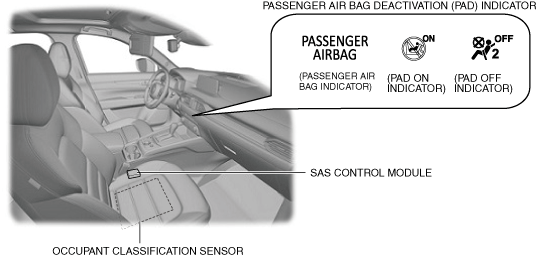 |
PASSENGER AIR BAG DEACTIVATION (PAD) SYSTEM [TWO-STEP DEPLOYMENT CONTROL SYSTEM]
id0810b1894400
Purpose
Function
|
Passenger seat status signal |
Passenger-side air bag module/passenger-side side air bag module/passenger-side front pre-tensioner seat belt |
PAD indicator |
||
|---|---|---|---|---|
|
Passenger air bag indicator |
PAD ON indicator |
PAD OFF indicator |
||
|
Adult
|
Operation (deployment) standby status
|
On
|
On
|
Off
|
|
Child
|
Operation (deployment) inhibited status
|
On
|
Off
|
On
|
Structure/Construction
ac5wzn00003776
|
Operation
Passenger seat status signal indicates adult
1. When the ignition is switched ON (engine off or on), the SAS control module sends (2) a PAD indicator request signal to the instrument cluster based on the passenger seat status signal (adult) (1).
2. When the ignition is switched ON (engine off or on), the indicator unit turns the transistor on (3).
3. When the transistor turns on, the passenger air bag indicator turns on (4).
4. The instrument cluster turns the transistor on (5) based on the PAD indicator request signal.
5. When the transistor turns on, the PAD ON indicator turns on (6).
6. The SAS control module operates (deploys) (7) the passenger-side air bag module, passenger-side side air bag module, and passenger-side front pre-tensioner seat belt.
7. When approx. 60 s have elapsed after the PAD ON indicator turns on, it turns off (8).
ac5wzn00003777
|
Passenger seat status signal indicates child
1. When the ignition is switched ON (engine off or on), the SAS control module sends (2) a PAD indicator request signal to the instrument cluster based on the passenger seat status signal (child) (1).
2. When the ignition is switched ON (engine off or on), the indicator unit turns the transistor on (3).
3. When the transistor turns on, the passenger air bag indicator turns on (4).
4. The instrument cluster turns the transistor on (5) based on the PAD indicator request signal.
5. When the transistor turns on, the PAD OFF indicator turns on (6).
6. The SAS control module inhibits operation (deployment) the passenger-side air bag module, passenger-side side air bag module, and passenger-side front pre-tensioner seat belt (7).
ac5wzn00003778
|
Fail-safe